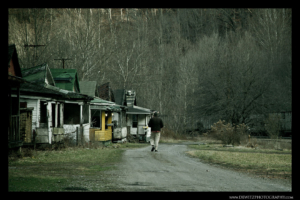
When one pictures intense poverty, the Appalachian region often comes to mind. The region has been historically characterized by a lack of opportunity, by exploitation, injustice, and an intense struggle just to survive. The 25 million people who currently inhabit its land — covering 420 counties across 13 states — face some of the most difficult economic circumstances of any region, with a 20 percent poverty level. In some Appalachian counties, the official rate of unemployment is double the national average.
It was no surprise that the region overwhelmingly supported Donald Trump in the face of the neoliberal status quo of represented by the Democratic Party candidate Hillary Clinton. In some of the region’s poorest counties, such as McDowell in West Virginia, over 60 percent of registered voters did not even bother to go to the polls, while 75 percent of those who did went for Trump.
Unfortunately, this misguided support for Trump’s false populist rhetoric has come back to bite those in the region with his announced 2018 budget. It includes a proposal to completely abolish the popular Appalachian Regional Commission. The ARC serves as a crucial lifeline to the people living in Appalachia, who depend on it for funding countless programs that benefit the lives of working people.
In 1965, when the ARC was first created, the U.S. federal government estimated that nearly one in three people living in Appalachia lived in harsh poverty with overall income levels roughly 23 percent lower than the rest of the country. Unemployment was such a rampant phenomenon that nearly 2 million people had left the region for work in the decade prior to the commission’s creation. Regional infrastructure to facilitate production and transportation of goods and services was nearly nonexistent.
Today, one of the key components of the ARC is providing funding for job training and skill development programs to combat the structural unemployment created by the lack of economic diversification. It also is a main institution in documenting the region’s problems, when much of the country’s academic institutions and big media centers look the other way.
Trump’s budget proposal also includes devastating cutbacks to senior centers, after-school, college prep and other educational programs, meals on wheels, community health clinics, scientific research, and the Labor Department. It came in tandem with his failed “Trump Care” bill that would have stripped drug addiction treatment from insurance plans. All of these cuts would have a huge impact on Appalachia.
The Trump regime’s arrogant proposal to abolish such programs is a clear slap in the face of working class families that supported him. But it is no surprise. A billionaire developer like Donald Trump doesn’t face the brutal dilemma of whether to take part in demolishing mountaintops to strip mine coal so that he can put food on his family’s table or to have clean drinking water in his community instead.
Trump doesn’t live in the communities where acid mine runoff leads to some of the highest rates of cancer and birth defects in the country. He certainly doesn’t have to deal with the heartbreaking tragedy of opioid addiction that plagues families in the region.
Working-class people in Appalachia have nothing in common with parasitic tycoons like Donald Trump, who instead represents the criminal coal barons that plague the region.
What is needed now is for the region to recognize and reject the fake-populist rhetoric being used to divide the region’s working class. Racist and anti-immigrant rhetoric is not something ingrained in the region. It runs counter to the proud militant union struggles, waged by people of all backgrounds and genders, that were waged in the region at the turn of the 20th century. It is scapegoating, pure and simple, and it gets the working class nowhere.
It is clear that the ruling capitalist class is unable to meet the needs of people in the Appalachian region and elsewhere. The socialist program is to reorganize society based on the rule of working people, to provide a high quality of life that guarantees meaningful work, education, healthcare, and a clean environment for all. The resources and technology exist to make such a world possible — and it’s up to us to fight for it.





